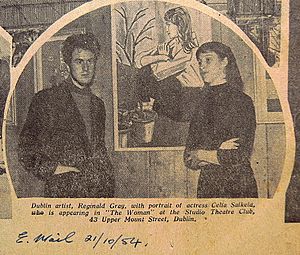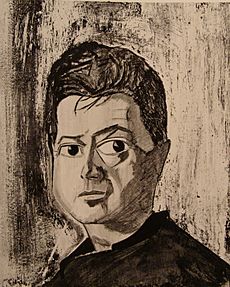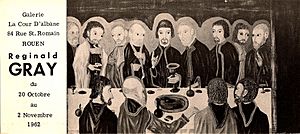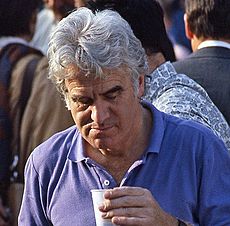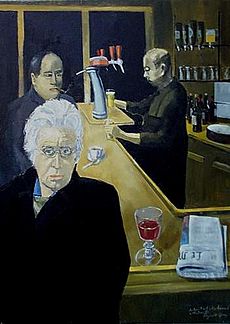Reginald Gray (artist) facts for kids
Quick facts for kids
Reginald Gray
|
|
|---|---|
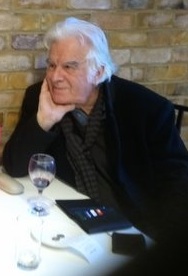
Gray in 2011
|
|
| Born | 1930 |
| Died | 29 March 2013 (aged 82–83) Paris, France
|
| Education | Cecil ffrench Salkeld. ARHA (1953–57) |
| Known for | Portrait painter and theatre set designer |
| Awards | Sandro Botticelli Prize. Florence, Italy (2004) |
Reginald Gray (1930 – 29 March 2013) was an Irish artist famous for painting portraits. He studied art in Dublin and then moved to London. There, he became part of a group of artists known as the School of London. This group included famous painters like Francis Bacon and Lucian Freud.
In 1960, Reginald Gray painted a portrait of Francis Bacon. This painting is now kept in the National Portrait Gallery in London. Gray also painted many other well-known people from real life. These included writers like Samuel Beckett and Harold Pinter, and fashion designer Yves Saint Laurent. In 1993, Gray had a big art show in UNESCO Paris. Later, in 2006, his painting called "The White Blouse" won an important award, the Sandro Botticelli Prize, in Florence, Italy.
Contents
Early Life and Art Training
Reginald Gray was born in Dublin, Ireland, in 1930. He grew up in a place called Blackrock. His father worked for the Guinness company. Gray went to school in Blackrock and then studied art at the National College of Art and Design in Dublin.
Learning from a Master
After a short time at the college, Gray decided to learn from a special teacher. He studied under Cecil Ffrench Salkeld, who was a member of the Royal Hibernian Academy (ARHA). This meant Salkeld was a very respected artist. Gray learned old painting techniques from him.
When he was 19, Gray joined a small group of painters called The Dublin Atelier. They showed their art at The Dublin Painters Gallery. During this time, Gray was inspired by the early works of a French painter named Bernard Buffet.
First Art Projects
In the early 1950s, Gray had his own art studio in Dublin. His first paid art job was for University College Dublin. He designed the sets and costumes for a play called The King's Threshold by W.B. Yeats. He also painted a portrait of the play's lead actor, John Jordan. This painting is now in The Dublin Writers Museum.
Gray became good friends with the writer Brendan Behan. Gray was even asked to be the best man at Behan's wedding. Gray also designed many sets for The Pike Theatre, a famous theatre in Dublin. He designed for plays like The Rose Tattoo by Tennessee Williams. He even traveled to Belfast to make bigger sets for a larger theatre.
Moving to London
In 1957, Gray moved to London. He first shared a flat with three Irish actors. But he needed more quiet time to paint, so he moved to Bayswater. He got a job at a department store called Whiteleys. He designed and decorated their display windows, but he still kept painting in his free time.
Meeting Famous Artists
In 1960, Gray had his first solo art show in London. It received good reviews. An American film actor, Patrick Waddington, bought some of Gray's paintings. He even helped Gray have an exhibition in New York.
A theatre director suggested that Gray should paint a portrait of the famous writer Samuel Beckett. Gray flew to Paris to work on this portrait. It was later shown in Dublin.
In the same year, Gray met the famous painter Francis Bacon in a pub. Bacon visited Gray's studio, and Gray drew a picture of him. Later, Gray used this drawing to create a painted portrait of Bacon. This portrait was bought by a collector and then given to the National Portrait Gallery in London in 1975. You can still see it there today!
Life in France
In 1963, Gray moved to Paris, France. On his way, he stopped in Rouen and had his first French art exhibition. Even though he got good reviews, his paintings didn't sell as well as they had in London. He lived in a very cheap room and had a tough winter. He even became a street artist, copying famous Renaissance paintings on the ground to earn money.
Things got better when he started working as an extra in operas at the Théâtre des Arts de Rouen. He showed his art at the Salon des Artistes Normands for three years before finally moving to Paris.
Paris and Ravenel
Gray arrived in Paris in mid-1964 with very little money. He would live there for the rest of his life. He lived in an art academy where sculptors worked. A sculptor and his students even built Gray a small room in the studio.
Gray worked as a copy editor for The New York Times in Paris. He also drew portraits of people being interviewed by the newspaper. These included the philosopher Jean-Paul Sartre and the singer Jacques Brel. Gray also worked as a fashion photographer for over five years, covering fashion shows in different cities.
He even directed his first full-length movie called Jeu. Later, Gray lived in a large house called Chateau de Ravenel, north of Paris, for ten years.
Later Years and Achievements
From 1993, Reginald Gray taught painting at the Irish College in Paris. In 1996, he directed and designed the sets for a play called Letters from Ireland. This play opened at the Wexford Festival and toured Ireland.
In his later years, Gray had many art shows in Paris. He also exhibited with the American artist Gregory Masurovsky. In 1994, UNESCO Paris held a large show of Gray's artworks.
His later paintings include portraits of the poet Ted Hughes and the Russian composer Alfred Schnittke. He also painted a portrait of Harold Pinter in 1998.
In 1995, Gray's 1960 portrait of Francis Bacon was hung in the National Portrait Gallery in London. In 2006, his painting "The White Blouse" won the Sandro Botticelli Prize in Florence, Italy.
Death
Reginald Gray passed away on March 29, 2013, in Paris. He was 82 years old.
Art Collections
Reginald Gray's artwork can be found in many public collections around the world. Some of these places include:
- Bankfield Museum, Halifax
- Dublin Writers Museum, Dublin
- Museum of London
- National Portrait Gallery, Canberra
- National Portrait Gallery, London
- Royal College of Music, London
- Saint Columba's College, Dublin


